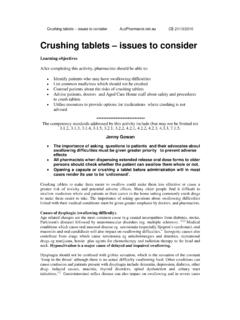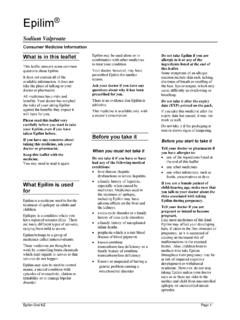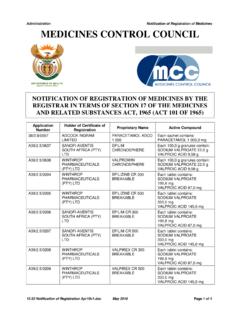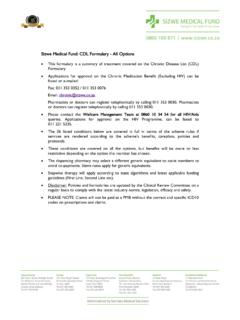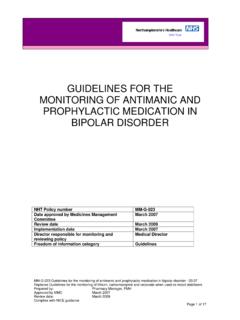Transcription of 2 QUALITATIVE AND QUANTITATIVE COMPOSITION
1 New Zealand Data Sheet 28 March 2018 epilim - sodium valproate epilim -ccdsv23-dsv19-28mar18 Page 1 DATA SHEET 1 PRODUCT NAME epilim 100 crushable t ablet, 100 mg epilim EC modified release tablet, 200 mg epilim EC modified release tablet, 500 mg epilim Syrup, 200 mg/5 mL epilim Liquid oral solution (sugar free), 200mg/5mL epilim Intravenous solution for injection, 100 mg/mL 2 QUALITATIVE AND QUANTITATIVE COMPOSITION epilim 100 Crushable Tablets contain 100 mg sodium valproate. epilim EC Modified Release Tablets contain 200 mg sodium valproate. epilim EC Modified Release Tablets contain 500 mg sodium valproate. epilim Syrup, each 5 mL of syrup contains 200 mg sodium valproate. epilim Liquid Oral Solution, each 5mL of liquid contains 200 mg sodium valproate. epilim Intraveous (IV) Solution for Injection - each pack contains one glass vial of 400 mg sodium valproate freeze-dried powder and one glass ampoule containing 4 mL of solvent (Water for Injections).
2 For the full list of excipients, see Section , List of Excipients. 3 PHARMACEUTICAL FORM Crushable tablet, 100 mg (white, scored). Modified release tablet, 200 mg (lilac, enteric-coated). New Zealand Data Sheet 28 March 2018 epilim - sodium valproate epilim -ccdsv23-dsv19-28mar18 Page 2 Modified release tablet, 500 mg (lilac enteric-coated). Syrup, 200 mg/5 mL (red, cherry flavoured). Oral solution sugar free liquid, 200 mg/5 mL (red, cherry flavoured) Powder 400 mg and solvent 4 mL for solution for injection. 4 CLINICAL PARTICULARS THERAPEUTIC INDICATIONS Epilepsy Primary generalised epilepsy (petit mal absences, various forms of myoclonic epilepsy and tonic-clonic grand mal seizures). Partial (focal) epilepsy either alone or as adjuvant therapy. Bipolar Disorder For the treatment of manic episodes, maintenance and prophylactic treatment of bipolar disease. epilim IV The treatment of patients with epilepsy or bipolar disorder, who would normally be maintained on oral sodium valproate, and for whom oral therapy is temporarily not possible.
3 DOSE AND METHOD OF ADMINISTRATION epilim tablets may be given twice daily. Uncoated tablets may be crushed if necessary however, unlike other scored tablets, the 100 mg tablets are not designed to be given as half doses. epilim Syrup and Sugar-Free Liquid should be given in divided doses. epilim should preferably be taken with or after food: the enteric-coated tablet (lilac) must be swallowed whole, if necessary with a little water: the plain tablet (white, 100 mg) may be taken whole or crushed and swallowed with water (not aerated). epilim 500 mg enteric-coated is recommended for patients requiring high doses. Where the possibility of dental caries represents a risk through long-term therapy with epilim Syrup, it may be beneficial to consider epilim Sugar-Free Liquid. epilim may take several days to show an initial effect and in some cases may take from 2 to 6 weeks to exhibit its maximum effect. New Zealand Data Sheet 28 March 2018 epilim - sodium valproate epilim -ccdsv23-dsv19-28mar18 Page 3 epilim oral - epilepsy Monotherapy Usual requirements are as follows: Adults Dosage should start with 600 mg daily increasing by 200 mg/day at three-day intervals until control is achieved.
4 This is generally within the range 1,000 to 2,000 mg/day, ( 20 to 30 mg/kg/day). Where adequate control is not achieved within this range the dose may be further increased to 2,500 mg/day. Children > 20 kg Initial dosage should be 400 mg/day (irrespective of weight) with spaced increases until control is achieved; this is usually within the range 20 to 30 mg/kg/day. Where adequate control is not achieved within this range, the dose may be increased to 35 mg/kg body weight per day. Children < 20 kg 20 mg/kg/day: in severe cases this may be increased but only in patients in whom plasma valproic acid levels can be monitored. Above 40 mg/kg/day, clinical chemistry and haematological parameters should be monitored. General considerations Optimum dosage is mainly determined by seizure control and routine measurement of plasma levels is unnecessary. However, a method for measurement of plasma levels is available and may be helpful where there is poor control or side effects are suspected.
5 epilim oral - bipolar disorder Initially dosage should start with 600 mg daily in 2 to 3 divided doses. From day 2 the dose should be increased as rapidly as possible to achieve the lowest therapeutic dose which produces the desired clinical effect. Daily doses generally within the range 1,000 to 2,000 mg/day, ( 20 to 30 mg/kg/day). Where adequate control is not achieved within this range the dose may be further increased to 2,500 mg/day. The Bowden et al study (see Section ) provided strong support for the greater efficacy of serum levels above 45 g/mL (these levels achieved 20% or greater improvement on both subscales of the Mania Rating Scale). Bowden noted that > 125 g/mL had greater drug-related adverse events. Between these extremes there does not appear to be a clear dose-response relationship. New Zealand Data Sheet 28 March 2018 epilim - sodium valproate epilim -ccdsv23-dsv19-28mar18 Page 4 Optimum dosage is mainly determined by control.
6 However, a method for measurement of plasma levels is available and may be helpful where there is poor control or side effects are suspected. epilim IV - epilepsy and bipolar disorder epilim IV may be given by direct slow intravenous injection or by slow intravenous infusion in NaCL (normal saline), 5% glucose solution or glucose saline, using a separate intravenous line. The recommended concentration of the intravenous infusion solution is 4 mg/mL, with 8 mg/mL being the maximum concentration. epilim IV should not be administered at the same time as other intravenous additives via the same IV line. The intravenous solution is suitable for infusion by PVC, polyethylene or glass containers. To reconstitute, inject the solvent provided (4mL) into the vial, allow to dissolve and extract the appropriate dose. Due to displacement of solvent by sodium valproate the concentration of reconstituted sodium valproate is 95mg/mL.
7 epilim IV should be replaced by oral epilim therapy as soon as practicable. Each ampoule of epilim IV is for single dose injection only. To reduce microbiological hazard, use as soon as practicable after reconstitution. If storage is necessary hold at 2 to 8 C for not more than 24 hours. epilim IV is intended for use in one patient on one occasion only, any unused portion should be discarded. NEVER ADMINISTER epilim IV OTHER THAN BY THE INTRAVENOUS ROUTE (see Section ). Monotherapy Daily dosage requirements vary according to age and body weight: Adults Patients already satisfactorily treated with epilim may be continued at their current dosage using continuous infusion. For example, a patient stabilised on 25 mg/kg administered daily should be continued with an infusion at the rate of 1 mg/kg/hr. Other patients may be given a slow intravenous injection over 3-5 minutes, usually 400-800 mg depending on body weight (up to 10 mg/kg) followed by continuous infusion of 1-2 mg/kg/hr up to a maximum of 2500 mg/day, according to the patient s clinical response.
8 Children The daily requirement for children is usually in the range 20-30 mg/kg/day and method of administration is as above. Where adequate control is not achieved within this range the dose may be increased up to 40 mg/kg/day but only in patients in whom plasma valproic acid levels can be New Zealand Data Sheet 28 March 2018 epilim - sodium valproate epilim -ccdsv23-dsv19-28mar18 Page 5 monitored. Above 40 mg/kg/day clinical chemistry and haematological parameters should be monitored. Special Populations Female children, female adolescents, women of childbearing potential and pregnant women Treatment should be initiated and supervised by a specialist experienced in the management of epilepsy or bipolar disorder. Treatment should only be initiated if other treatments are ineffective or not tolerated (see Section and Section ) and the benefit and risk should be carefully reconsidered at regular treatment reviews.
9 Preferably epilim should be prescribed as monotherapy and at the lowest effective dose, if possible as a prolonged release formulation. The daily dose should be divided into at least two single doses during pregnancy. Use in hepatic impairment Liver dysfunction, including hepatic failure resulting in fatalities, has occurred in patients whose treatment included valproic acid or sodium valproate (see Section ). Use in renal impairment Lower doses may be required since free drug levels may be high owing to lowered serum albumin and poor urinary excretion of free drug metabolites (see Section ). Dosage should be adjusted according to clinical monitoring since monitoring of plasma concentrations may be misleading. (See Section ). Use in elderly Although the pharmacokinetics of epilim are modified in the elderly, they have limited clinical significance and dosage should be determined by seizure control and/or control of symptoms.
10 The volume of distribution is increased in the elderly and because of decreased binding to serum albumin, the proportion of free drug is increased. This will affect the clinical interpretation of plasma valproic acid levels. Paediatric population Use in children and adolescents: The safety and efficacy of sodium valproate for the treatment of manic episodes in bipolar disorder have not been evaluated in patients aged less than 18 years. Combined Therapy When starting epilim in patients on other anticonvulsants, these should be tapered slowly: initiation of epilim therapy should then be gradual, with target dose being reached after about 2 New Zealand Data Sheet 28 March 2018 epilim - sodium valproate epilim -ccdsv23-dsv19-28mar18 Page 6 weeks. In certain cases it may be necessary to raise the dose by 5 to 10 mg/kg/day when used in combination with anticonvulsants, which induce liver enzyme activity, phenytoin, phenobarbital and carbamazepine.











